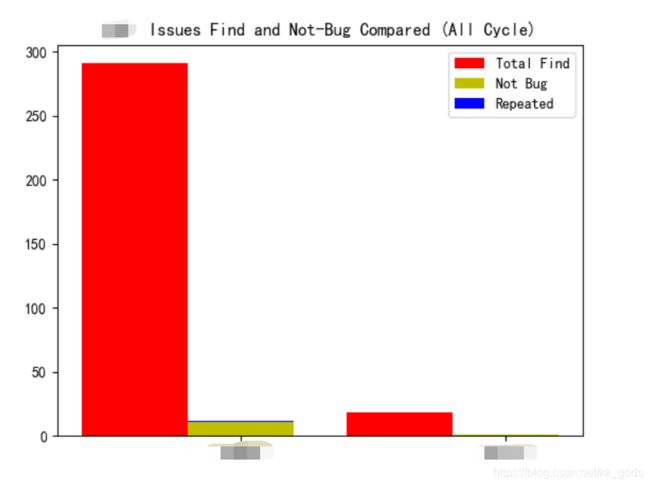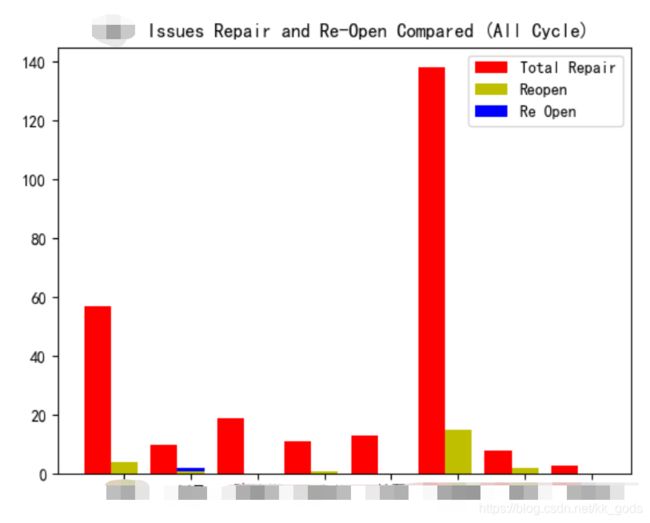基于jira的缺陷自动化报表分析 (十)matplotlib 竖向并列叠加柱状图:各种对比分析
接前文 基于jira的缺陷自动化报表分析 (九)matplotlib 横向叠加柱状图:缺陷人员、模块、原因、引入阶段分析
还剩以下5种图形未实现:缺陷引入数量与加权数量对比分布、缺陷发现数量与加权数量对比分布、缺陷发现数量与无效数量对比分布、缺陷修复数量与被打回数量对比分布、缺陷发现与修复数量对比分布,我们需要绘制一个竖向并列叠加柱状图解决以上五种缺陷分析图表
一、绘图类
1、继续复制黏贴pass
# coding=utf-8
import matplotlib.pyplot as plt
import matplotlib.ticker as ticker
plt.rcParams['font.sans-serif'] = ['simhei'] # 用来正常显示中文标签
plt.rcParams['axes.unicode_minus'] = False # 用来正常显示负号
class Draw:
"""
绘图
"""
def __init__(self, reportpath):
self.reportpath = reportpath
def drawing_cake(self, amounts, lebals, project_name, title):
"""
绘制饼状图
"""
pass
def drawing_linechart_more(self, project_name, title, x_lebal, *y_labels, **kw):
"""
绘制折线图:单线条或多线条
"""
pass
def drawing_histogram_verlay(self, title, x_lables, *args, **kwargs):
""" 绘制横向叠加柱状图:可支持叠加任意多次 """
pass
2、开始编写绘制竖向并列可叠加柱状图
def drawing_histogram_tied(self, project_name, title, name_list, total_accounts, *num_lists, **kw):
"""
绘制并列柱状图(对比图,第二列可叠加任意多次)
"""
total_width, n = 0.8, 2
width = total_width / n
x = list(range(len(total_accounts)))
plt.bar(x, total_accounts, width=width, label=kw['lables'][0], fc=kw['fc'][0]) # 绘制第一列:总数
for i in range(len(x)):
x[i] = x[i] + width
for s in range(len(num_lists)):
bottom = None if s == 0 else num_lists[s-1]
# 绘制第二列:叠加
plt.bar(x, num_lists[s], width=width, bottom=bottom,
label=kw['lables'][s+1], tick_label=name_list, fc=kw['fc'][s+1])
plt.legend()
plt.title(project_name + ' ' + title)
plt.savefig(self.reportpath + '/' + project_name + ' ' + title + ".png")
plt.show()
plt.cla()
plt.close("all")
二、统计
1、继续复制黏贴(我们仍然绘制的是柱状图,所以继续在 Histogram 类编写,不再新建类)
# coding=utf-8
import datetime
from ana_jira import Ana_jira
from draw import Draw
from common.mysqluntil import MysqlUntil
# 柱状图颜色
fc = ('r', 'y', 'b', 'g')
class Histogram:
def __init__(self, project_name, test_jira, first_day, last_day, types, weeks, report_path, assignee):
self.project_name = project_name
self.test_jira = test_jira
self.first_day = first_day
self.last_day = last_day
self.types = types
self.weeks = weeks
self.report_path = report_path
self.assignee = assignee
2、缺陷版本发现数量与修复数量对比分析
def histogram_find_repair(self):
"""
:return:
"""
sql = """
SELECT A.test_version,A.resolution_counts,B.find_counts FROM
(
SELECT test_version,COUNT(id) AS resolution_counts FROM `jira_resolution_issues`
WHERE project='{project}' AND issuetype='故障'
GROUP BY test_version
)A,
(
SELECT test_version,COUNT(id) AS find_counts FROM `jira_issues`
WHERE project='{project}' AND issuetype='故障'
GROUP BY test_version
)B
WHERE A.test_version = B.test_version
""".format(project=self.project_name)
datas = MysqlUntil().mysql_select(sql)
# 版本发现数量、修复数量对比
test_version, resolution_counts, find_counts = [], [], []
for data in datas:
test_version.append(data['test_version'] if data['test_version'] else 'unfilled')
resolution_counts.append(int(data['resolution_counts']) if data['resolution_counts'] else 0)
find_counts.append(int(data['find_counts']) if data['find_counts'] else 0)
if len(test_version):
# 版本发现数量、修复数量对比
lable = ('Total Find', 'Total Solve')
Draw(self.report_path).drawing_histogram_tied(self.project_name,
' Issues Find and Solve Compared (All Cycle)',
test_version,
find_counts,
resolution_counts,
lables=lable, fc=fc)
print('缺陷发现总数与解决总数对比图:最近{}周数据统计完成'.format(self.weeks))
else:
print('缺陷发现总数与解决总数对比图:最近{}周无数据'.format(self.weeks))3、缺陷修复数量与被打回数量对比分析
def histogram_dev_re(self):
"""
绘制柱状图(被打回、重新引入)
:param project_name:
:return:
"""
sql = """
SELECT
assignee,
count(id) as total_accounts,
SUM(reopen_count) AS reopen_count,
SUM(re_open_count) AS re_open_count
FROM jira_resolution_issues
WHERE project='{}' AND issuetype='故障' AND resolution='完成'
GROUP BY project,assignee
ORDER BY project;
""".format(self.project_name)
datas = MysqlUntil().mysql_select(sql)
# 修复缺陷数与被打回、重复引入对比图
assignee, total_accounts, reopen_count, re_open_count = [], [], [], []
for data in datas:
assignee.append(data['assignee'] if data['assignee'] else 'unfilled')
total_accounts.append(int(data['total_accounts']) if data['total_accounts'] else 0)
reopen_count.append(int(data['reopen_count']) if data['reopen_count'] else 0)
re_open_count.append(int(data['re_open_count']) if data['re_open_count'] else 0)
if len(assignee):
lables = ('Total Repair', 'Reopen', 'Re Open')
# 修复缺陷数与被打回、重复引入对比图
Draw(self.report_path).drawing_histogram_tied(
self.project_name, ' Issues Repair and Re-Open Compared (All Cycle)',
assignee, total_accounts, reopen_count, re_open_count, lables=lables, fc=fc)
print('总修复缺陷数与被打回、重新引入对比图:最近{}周数据统计完成'.format(self.weeks))
else:
print('总修复缺陷数与被打回、重新引入对比图:最近{}周无数据'.format(self.weeks))4、缺陷开发引入数量与加权数量对比分析
def histogram_assignee_weighted_quantity(self):
"""
绘制柱状图:开发人员单项目缺陷数量分布
:param project_name:
:return:
"""
sql = """
SELECT assign_name, SUM(introduce_amount) as introduce_amount, SUM(weighted_quantity) AS weighted_quantity
FROM daily_assign_bug
WHERE project_name = '{}' AND date BETWEEN "{}" AND "{}"
GROUP BY user_name
HAVING weighted_quantity>0;
""".format(self.project_name, self.first_day, self.last_day)
datas = MysqlUntil().mysql_select(sql)
# 缺陷加权数量
assign_name, introduce_amount, weighted_quantity = [], [], []
for data in datas:
assign_name.append(data['assign_name'] if data['assign_name'] else 'unfilled')
introduce_amount.append(int(data['introduce_amount']) if data['introduce_amount'] else 0)
weighted_quantity.append(int(data['weighted_quantity']) if data['weighted_quantity'] else 0)
if assign_name:
lables = ('total introduce', 'weighted quantity')
Draw(self.report_path).drawing_histogram_tied(
self.project_name, ' Issues Dev Weighted Quantity Distribution (week)',
assign_name,
introduce_amount, weighted_quantity,
lables=lables, fc=fc)
print('项目{}最近{}周开发人员缺陷分布统计完成'.format(self.project_name, self.weeks))
else:
print('项目{}最近{}周未提交缺陷,无法统计开发人员缺陷分布'.format(self.project_name, self.weeks))5、缺陷测试发现数量与加权数量对比分析
def histogram_test_weighted_quantity(self):
"""
绘制柱状图:开发人员单项目缺陷数量分布
:param project_name:
:return:
"""
sql = """
SELECT test_name, SUM(find_amount) as find_amount,SUM(weighted_quantity) AS weighted_quantity
FROM daily_test_bug
WHERE project_name = '{}' AND date BETWEEN "{}" AND "{}"
GROUP BY user_name
HAVING weighted_quantity>0;
""".format(self.project_name, self.first_day, self.last_day)
datas = MysqlUntil().mysql_select(sql)
# 缺陷加权数量
test_name, find_amount, weighted_quantity = [], [], []
for data in datas:
test_name.append(data['test_name'] if data['test_name'] else 'unfilled')
find_amount.append(int(data['find_amount']) if data['find_amount'] else 0)
weighted_quantity.append(int(data['weighted_quantity']) if data['weighted_quantity'] else 0)
if test_name:
lables = ('total find', 'weighted quantity')
Draw(self.report_path).drawing_histogram_tied(
self.project_name, ' Issues Test Weighted Quantity Distribution (week)',
test_name,
find_amount, weighted_quantity,
lables=lables, fc=fc)
print('项目{}最近{}周开发人员缺陷分布统计完成'.format(self.project_name, self.weeks))
else:
print('项目{}最近{}周未提交缺陷,无法统计开发人员缺陷分布'.format(self.project_name, self.weeks))6、缺陷测试发现与无效数量对比分析
def histogram_test_re(self):
"""
绘制柱状图(不是BUG、重复提交)
:param project_name:
:return:
"""
sql = """
SELECT
test_name,
SUM(find_amount) AS total_amounts,
SUM(refuse_amount) AS refuse_amount,
SUM(repeat_amount) AS repeat_amount
FROM
daily_test_bug
where project_name = '{}'
GROUP BY
project_name,
user_name
HAVING
SUM(find_amount) + SUM(refuse_amount) > 0
ORDER BY
project_name;
""".format(self.project_name)
datas = MysqlUntil().mysql_select(sql)
# 发现缺陷总数与无效BUG(不是BUG、重复提交)对比
test_name, total_accounts, refuse_amount, repeat_amount = [], [], [], []
for data in datas:
test_name.append(data['test_name'] if data['test_name'] else 'unfilled')
total_accounts.append(int(data['total_amounts']) if data['total_amounts'] else 0)
refuse_amount.append(int(data['refuse_amount']) if data['refuse_amount'] else 0)
repeat_amount.append(int(data['repeat_amount']) if data['repeat_amount'] else 0)
if len(test_name):
lable = ('Total Find', 'Not Bug', 'Repeated')
# 发现缺陷总数与无效BUG(不是BUG、重复提交)对比
Draw(self.report_path).drawing_histogram_tied(self.project_name,
' Issues Find and Not-Bug Compared (All Cycle)',
test_name,
total_accounts,
refuse_amount, repeat_amount,
lables=lable, fc=fc)
print('缺陷总发现数与无效BUG对比图:最近{}周数据统计完成'.format(self.weeks))
else:
print('缺陷总发现数与无效BUG对比图:最近{}周无数据'.format(self.weeks))
三、执行统计
his = Histogram(project_name, test_jira, first_day, last_day, types, weeks, project_report_path, assignee)
his.histogram_find_repair() # (项目、版本)发现、修复对比
his.histogram_dev_re() # (开发人员)修复缺陷数与被打回、重复引入对比图
his.histogram_assignee_weighted_quantity() # (开发人员)缺陷数量、加权数量对比分布
his.histogram_test_weighted_quantity() # (测试人员) 缺陷数量、加权数量对比分布
his.histogram_test_re() # (测试人员)发现缺陷总数与无效BUG(不是BUG、重复提交)对比1、缺陷引入数量与加权数量对比分布
2、缺陷发现数量与加权数量对比分布
3、缺陷发现数量与无效数量对比分布
4、缺陷修复数量与被打回数量对比分布
5、缺陷发现与修复数量对比分布(按版本对比)




